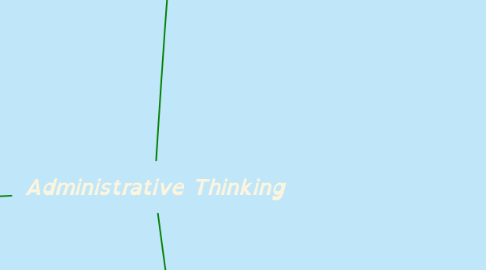
1. XXI century
1.1. Communication, technology, information and virtuality
1.2. The virtual organization.
1.3. Creativity and innovation
1.4. competitiveness
1.5. knowledge and learning
1.6. Trust and cooperation
1.7. Administration Challenges
1.7.1. propose theories, models, methods and tools that respond to specific space-time conditions.
2. Administrative approach contemporary
2.1. develops after the second World War
2.2. it is characterized by
2.2.1. the social
2.2.2. the human
2.2.3. the participation
2.2.4. the trust
2.2.5. the autonomy of the worker
2.2.6. empowerment
2.2.7. team work
2.2.8. "Homo social"
2.3. powered by
2.3.1. technological development
2.3.2. constantly changing environments
2.3.3. more competitive and demanding markets
2.3.4. accelerated changes in communication processes
2.3.5. innovation and development
2.4. approaches that emerge from this
2.4.1. Management by objectives (Peter Drucker).
2.4.1.1. All employees must aim to contribute to the organization from their assigned functions and tasks, without losing sight of its general objectives.
2.4.2. Administrative decision-making The decision, a power that is attributed or a skill that is developed? For G. Morgan (1986)
2.4.3. Strategic planning Chandler (1962)
2.4.3.1. The planning process includes investigating and analyzing future conditions in order to draw up an action plan that the organization can follow, taking into account all the information from the internal and external environment.
2.4.4. The philosophy of total quality and the productivity (Deming, Juran, Ishikawa).
2.4.4.1. Quality control is a highly rational instrument for the management of organizations, whose main objective is to try to reduce and control the costs of operations and increase the productivity of all levels of the organization, which is expressed in profits.
2.4.5. The study of organizational culture and the organization as culture. Elliot Jacques, Erving Goffman, Chester Barnard, and Paul Selznik
2.4.6. Reengineering (Hammer and Champy -1993)
2.4.6.1. total change of the productive and administrative practices of the company
2.4.7. Competitive Benchmarking (Michael Spendolini-1994)
2.4.7.1. systematic and continuous process to evaluate products, services and work processes
2.4.8. Outsourcing
2.4.8.1. deregulate labor relations, to make it easier for companies to concentrate on their critical processes, and leave the rest to third parties
3. Book highlights
3.1. Classical Administration Theory
3.1.1. Scientific Administration
3.1.1.1. Main authors
3.1.1.1.1. Frederick Winslow Taylor
3.1.1.1.2. Henry Lawrence Gantt
3.1.1.1.3. Frank Bunker Gilberth
3.1.1.1.4. Harrington Emerson
3.1.1.1.5. Henry Ford
3.1.1.2. Main Pillars
3.1.1.2.1. Work analysis, time and motion study
3.1.1.2.2. Study of human fatigue
3.1.1.2.3. Division of labor and specialization of the worker
3.1.1.2.4. Designs of positions and tasks
3.1.1.2.5. Wage incentives and bonuses for production from standard production
3.1.1.2.6. Conceptualization of the worker as homo economicus
3.1.1.2.7. Adequacy of environmental conditions of the work site
3.1.1.2.8. Rationality of work
3.1.1.2.9. Standardization of methods and machines
3.1.1.2.10. Functional work supervision
3.1.1.2.11. homework emphasis
3.1.2. Anatomist and Physiologist Current of the Organization
3.1.2.1. Main authors
3.1.2.1.1. Henry Fayol
3.1.2.1.2. James D. Money
3.1.2.1.3. Lyndall Urwick
3.1.2.1.4. Luther Gulick
3.1.2.2. Basic functions
3.1.2.2.1. Technique
3.1.2.2.2. Financial Accountant
3.1.2.2.3. Commercial
3.1.2.2.4. Security
3.1.2.2.5. administrative
3.1.2.3. General management principles
3.1.2.3.1. Fair remuneration of staff
3.1.2.3.2. Concentration of authority in the top management of the company
3.1.2.3.3. Subordination of private interests to general ones
3.1.2.3.4. Initiative of everyone in the company
3.1.2.3.5. steering unit
3.1.2.3.6. command unit
3.1.2.3.7. staff stability
3.1.2.3.8. Team spirit
3.1.2.3.9. Equity and justice in relationships with staff
3.1.2.3.10. Division of labour
3.1.2.3.11. Discipline
3.2. Breaking point: General systems theory
3.2.1. Main authors
3.2.1.1. Ludwing Bertalanffy
3.2.2. contributes
3.2.2.1. new rationalism
3.2.2.2. new idea of administrative process
3.2.3. change
3.2.3.1. direction of organizational theories
3.2.4. the organization, begins to see itself as a social system immersed in a suprasystem called society and in particular to recognize itself as a vital component of this
3.2.5. types of systems
3.2.5.1. open systems
3.2.5.2. closed systems
